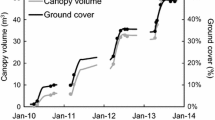Abstract
Modeling of crop transpiration is important to manage the irrigation strategy in soilless culture. In this study, the transpiration of paprika plants (Capsicum annuum L.) grown in rockwool was analyzed considering the relationship between incident radiation (RAD) and leaf area index (LAI). Coefficients of the simplified Penman-Monteith formula were calibrated in order to calculate the transpiration rate of the crop (Tr). Transpiration rate per floor area was measured by weighing plants with load cells. The following model was developed: Tr = a [1 − exp(−k × LAI)] × RAD /λ + b for estimating transpiration of paprika. Determination coefficient for the linear regression between estimations and measurements of daily transpiration was 0.80 with a slope of 0.93. In validation, the model showed high agreement between estimated and measured values of daily transpiration. Radiation showed a great effect on transpiration of paprika plants. The results indicated the simplified Penman- Monteith formula could be used to predict water requirements and improve irrigation control in soilless culture. However the model coefficients require parameter adjustments for specific climate and crop conditions.
Similar content being viewed by others
Literature Cited
Antony, E. and R.B. Singadhupe. 2004. Impact of drip and surface on growth, yield and WUE of capsicum (Casicum annuum L.). Agr. Water Manage 65:121–132.
Boulard, T. and R. Jemaa. 1993. Greenhouse tomato crop transpiration model application to irrigation control. Acta Hort. 355:381–387.
Baille, M., A. Baill, and J.C. Laury. 1994. A simplified model for predicting evapotranspiration rate of nine ornamental species vs. climate factors and leaf area. Sci. Hort. 59:217–232.
Boulard, T. and S. Wang. 2000. Greenhouse crop transpiration simulation from external climate conditions. Agr. For. Moteorol. 100:25–34.
Carmassi, G., L. Incrocci, R. Maggini, F. Malorgio, F. Tognoni, and A. Pardossi. 2007. An aggregated model for water requirements of greenhouse tomato grown in closed rockwool culture with saline water. Agr. Water Manage. 88:73–82.
De Graaf, R. and J. Van den Ende. 1981. Transpiration of evapotranspiration of the glasshouse crops. Acta Hort. 119:147–158.
Hamer, P.J.C. 1996. Validation of model used for irrigation control of a greenhouse crop. Acta Hort. 458:75–81.
Jolliet, O. and B.J. Bailley. 1992. The effect of climate on tomato transpiration in greenhouse: measurements and models comparison. Agr. For. Meteorol. 58:43–63.
Marcelis, L.F.M., E. Heuvelink, and J. Goudrian. 1998. Modeling biomass production and yield of horticultural crops: a review. Sci. Hort. 74:83–111.
Moreno, M.M., F. Ribas, A. Moreno, and M.J. Cabello. 2003. Physiological response of a pepper (Capsicum annuum L.) crop to different trickle irrigation rate. J. Spain Agri. Hort. 1:65–74.
Motulsky, H. and A. Christopoulos. 2003. Fitting models to biological data using linear and nonlinear regression. A practical guide to curve fitting. GraphPad Sofware Inc. San Diego. CA., USA.
Medrano, E., P. Lorenzo, M.C. Sanchez-Guerrero, and J.I. Montero. 2005. Evaluation and modeling of greenhouse cucumber-crop transpiration under high and low radiation conditions. Sci. Hort. 105: 163–175.
Nedefhoff, E.M. 1984. Light interception of a cucumber crop at different stages of growth. Acta Hort. 148:525–534.
Nobel, P.S. and S.P. Long. 1985. Canopy structure and light interception, pp. 41–49. In: J. Coombs, D.O. Hal, S.P. Long, and J.M.O. Scurlock (eds.). Techniques in bioproductivity and photosynthesis. Pergamon Press. Oxford. UK.
Stanghellini, C. 1987. Transpiration of greenhouse crops: an aid to climate management. PhD dissertation. Wageningen Agricultural University, Wageningen, Netherlands, p. 150.
Smittle, D.A., W.L. Dickens, and J.R. Stansell. 1994. Irrigation regimes affect yield and water use by bell pepper. J. Amer. Soc. Hort. Sci. 119:396–939.
Senzen, S.M., A. Yazar, and S. Eker. 2006. Effect of drip irrigation regimes on yield and quality of filed grown bell pepper. Agr. Water Manage. 81:115–131.
Author information
Authors and Affiliations
Corresponding author
Rights and permissions
About this article
Cite this article
Ta, T.H., Shin, J.H., Ahn, T.I. et al. Modeling of transpiration of paprika (Capsicum annuum L.) plants based on radiation and leaf area index in soilless culture. Hortic. Environ. Biotechnol. 52, 265–269 (2011). https://doi.org/10.1007/s13580-011-0216-3
Received:
Accepted:
Published:
Issue Date:
DOI: https://doi.org/10.1007/s13580-011-0216-3




